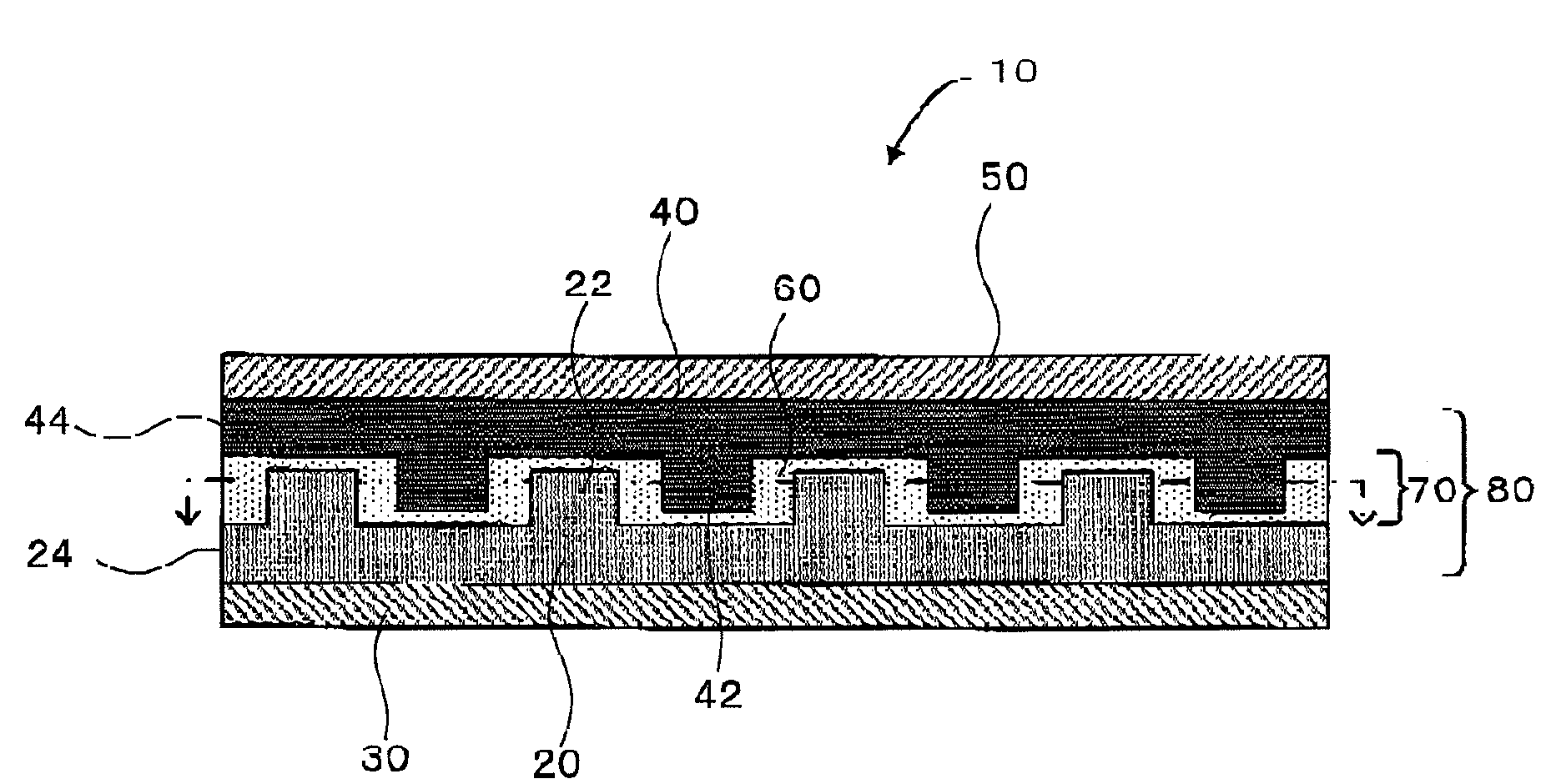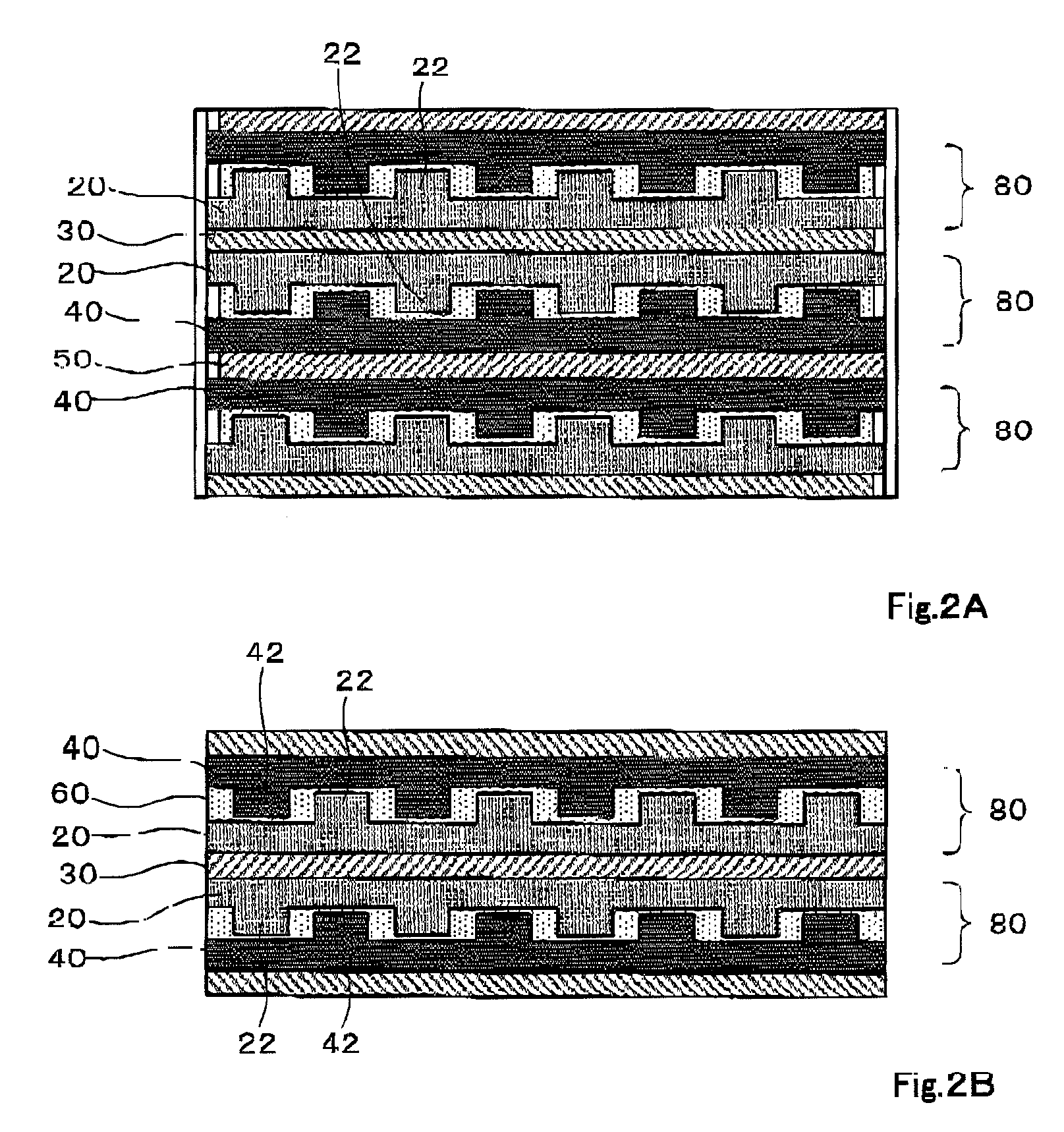All-solid battery element
a battery element and all-solid technology, applied in the direction of cell components, non-aqueous electrolyte cells, sustainable manufacturing/processing, etc., can solve the problems of local short circuit between the cathode and the anode, cracks, and internal impedance drop, so as to enhance ion conductivity, reduce the thickness of the electrolyte layer, and reduce the internal impedance
- Summary
- Abstract
- Description
- Claims
- Application Information
AI Technical Summary
Benefits of technology
Problems solved by technology
Method used
Image
Examples
first embodiment
[0037]An all-solid battery element 10 in a first embodiment of the invention is described with reference to FIGS. 1 through 7. As shown in FIG. 1, the all-solid battery element 10 of the first embodiment has a specific electrode array structure where a cathode 20 and an anode 40 are arranged in a zigzag manner respectively and alternative manner to form a checkered pattern as a whole. The all-solid battery element 10 has a unit cell 80 including the cathode 20, the anode 40, and a solid electrolyte layer 60 The unit cell 80 has at least one electrode-solid electrolyte assembly 70, which includes cathode parts 22 having a cathode active material, anode parts 42 having an anode active material, and the solid electrolyte layer 60. A cathode collector 30 and an anode collector 50 are provided respectively outside the cathode 20 and the anode 40 of the all-solid battery element 10. The cathode collector 30 and the anode collector 50 are respectively connected to appropriate external elec...
second embodiment
[0073]An all-solid battery element 210 in a second embodiment of the invention is described with reference to FIGS. 8 through 12. The like constituents to those of the first embodiment are expressed by the like numerals. The all-solid battery element 210 of the second embodiment has a specific electrode array structure where at least part of a cathode 220 and at least part of an anode 240 are arranged not zigzag but simply in an alternate manner. One example of the electrode array structure is shown in FIG. 8A and FIG. 8B. In the electrode array structure of FIG. 8A and FIG. 8B, band-like cathode parts 222 and band-like anode parts 242 are arranged alternately and parallel to such other in the solid electrolyte layer 60. Namely the solid electrolyte layer 60 has cavities for receiving the cathode bands 222 and the anode bands 242 alternately. This arrangement desirably attains the cell functions in a direction perpendicular to the laminating direction of the all-solid battery elemen...
third embodiment
[0082]An all-solid battery element 310 in a third embodiment of the invention is described with reference to FIG. 13A and FIG. 13B. The like constituents to those of the first embodiment are expressed by the like numerals. In the all-solid battery element 310 of the third embodiment, at least part of a cathode 320 and at least part of an anode 340 forming a specific electrode array structure have hollow spaces in the solid electrolyte layer 60. One example of the electrode array structure is shown in FIG. 13. The electrode array structure of this embodiment formed in the solid electrolyte layer 60 has cathode parts 322 as the part of the cathode 320 protruded into the solid electrolyte layer 60 and anode parts 342 as the part of the anode 340 protruded into the solid electrolyte layer 60.
[0083]The cathode parts 322 and the anode parts 342 respectively have hollow spaces 330 and 350. The hollow spaces 330 and 350 of the cathode parts 322 and the anode parts 342 may be open to communi...
PUM
 Login to View More
Login to View More Abstract
Description
Claims
Application Information
 Login to View More
Login to View More - R&D
- Intellectual Property
- Life Sciences
- Materials
- Tech Scout
- Unparalleled Data Quality
- Higher Quality Content
- 60% Fewer Hallucinations
Browse by: Latest US Patents, China's latest patents, Technical Efficacy Thesaurus, Application Domain, Technology Topic, Popular Technical Reports.
© 2025 PatSnap. All rights reserved.Legal|Privacy policy|Modern Slavery Act Transparency Statement|Sitemap|About US| Contact US: help@patsnap.com



